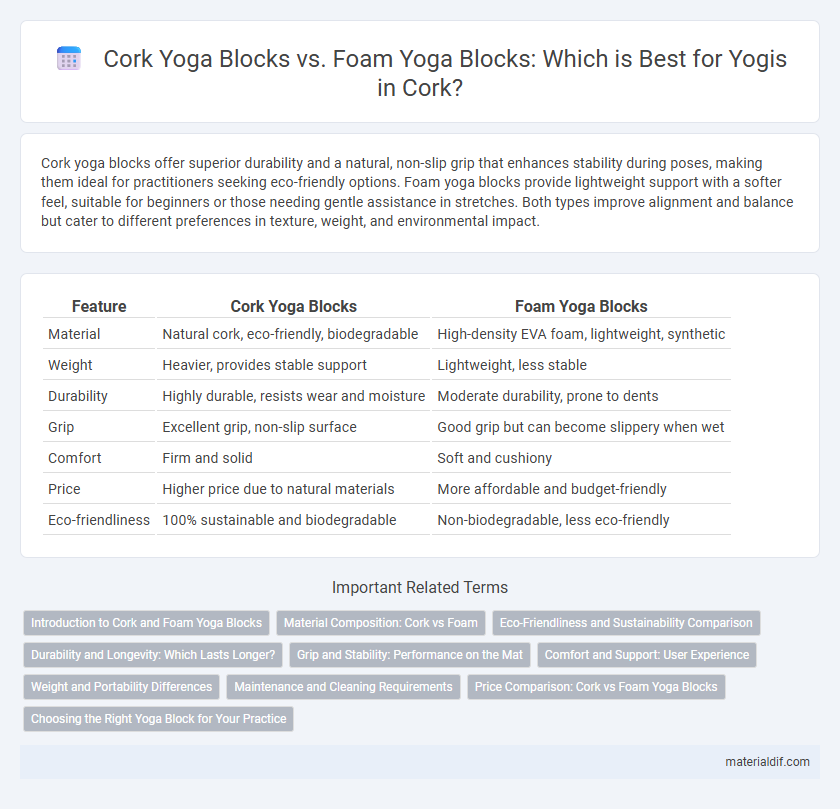Cork yoga blocks offer superior durability and a natural, non-slip grip that enhances stability during poses, making them ideal for practitioners seeking eco-friendly options. Foam yoga blocks provide lightweight support with a softer feel, suitable for beginners or those needing gentle assistance in stretches. Both types improve alignment and balance but cater to different preferences in texture, weight, and environmental impact.
Table of Comparison
| Feature | Cork Yoga Blocks | Foam Yoga Blocks |
|---|---|---|
| Material | Natural cork, eco-friendly, biodegradable | High-density EVA foam, lightweight, synthetic |
| Weight | Heavier, provides stable support | Lightweight, less stable |
| Durability | Highly durable, resists wear and moisture | Moderate durability, prone to dents |
| Grip | Excellent grip, non-slip surface | Good grip but can become slippery when wet |
| Comfort | Firm and solid | Soft and cushiony |
| Price | Higher price due to natural materials | More affordable and budget-friendly |
| Eco-friendliness | 100% sustainable and biodegradable | Non-biodegradable, less eco-friendly |
Introduction to Cork and Foam Yoga Blocks
Cork yoga blocks are crafted from natural cork harvested from the bark of cork oak trees, providing a firm, non-slip, and eco-friendly support ideal for stability in yoga practice. Foam yoga blocks are made from lightweight, closed-cell EVA foam that offers softness and cushioning, making them suitable for beginners or those needing gentle support. Both types enhance alignment and balance, but cork blocks are preferred for durability and sustainability, while foam blocks prioritize comfort and affordability.
Material Composition: Cork vs Foam
Cork yoga blocks are made from natural, sustainable cork harvested from cork oak trees, offering a firm, eco-friendly support with excellent grip and durability. Foam yoga blocks consist of lightweight, high-density EVA foam, providing a softer, more cushioned surface suitable for beginners or practitioners needing gentler support. While cork blocks excel in stability and moisture resistance, foam blocks offer superior portability and affordability, catering to different yoga practice preferences.
Eco-Friendliness and Sustainability Comparison
Cork yoga blocks are highly sustainable due to their biodegradable nature and renewable cork oak harvesting process, minimizing environmental impact. Foam yoga blocks, typically made from non-biodegradable EVA foam, contribute to long-term pollution and rely on fossil fuel-derived materials. Choosing cork blocks supports eco-friendly practices and reduces plastic waste, aligning with green yoga and sustainable lifestyle values.
Durability and Longevity: Which Lasts Longer?
Cork yoga blocks offer superior durability due to their dense, natural material that resists cracking and deformation over time, making them ideal for long-term use. Foam yoga blocks, while lightweight and affordable, tend to compress and lose shape with regular use, reducing their longevity. Investing in cork blocks ensures sustained support and resilience for rigorous yoga practice.
Grip and Stability: Performance on the Mat
Cork yoga blocks provide superior grip and enhanced stability on the mat due to their natural, non-slip texture that maintains firmness even when wet with sweat. Foam yoga blocks, while lightweight and cushioned, tend to lose traction as they absorb moisture, potentially compromising balance during poses. Choosing cork blocks improves overall performance by offering a steady foundation essential for maintaining alignment and confidence in various yoga practices.
Comfort and Support: User Experience
Cork yoga blocks provide a firm, non-slip surface that offers stable support for various poses, enhancing balance and confidence during practice. Foam yoga blocks deliver a softer, more cushioned feel, reducing pressure on joints and increasing overall comfort, especially for beginners or those with sensitive knees and wrists. Choosing between cork and foam blocks depends on personal preference for either a solid, durable base or a lightweight, gentle support to improve user experience.
Weight and Portability Differences
Cork yoga blocks are denser and heavier, offering greater stability for balancing poses but may be less portable for travel. Foam yoga blocks are lightweight and more compact, making them ideal for carrying to classes or trips without adding bulk. The choice between cork and foam primarily depends on whether stability or ease of transport is prioritized in a yoga practice.
Maintenance and Cleaning Requirements
Cork yoga blocks require minimal maintenance due to their natural antimicrobial properties, resisting odors and bacteria buildup while cleaning easily with a damp cloth. Foam yoga blocks demand more frequent cleaning to prevent dirt and sweat accumulation, often requiring soap and water or disinfectant wipes for thorough sanitation. The durability of cork also helps maintain its structural integrity longer under regular cleaning compared to the more porous foam material.
Price Comparison: Cork vs Foam Yoga Blocks
Cork yoga blocks generally cost more than foam yoga blocks due to their natural material and durability, with prices typically ranging from $15 to $25 per block compared to $5 to $15 for foam alternatives. Cork blocks offer eco-friendly benefits and better grip, justifying their higher price point for many yoga practitioners. Foam blocks, while more affordable and lightweight, may wear out faster and lack the sustainable qualities of cork.
Choosing the Right Yoga Block for Your Practice
Cork yoga blocks offer a sturdy, non-slip grip and natural eco-friendly material, making them ideal for stability in various yoga poses. Foam yoga blocks provide lightweight support and cushioning, perfect for beginners and practices requiring softer contact. Selecting the right yoga block depends on your practice style, preference for sustainability, firmness, and ease of transport.
Cork Yoga Blocks vs Foam Yoga Blocks Infographic

 materialdif.com
materialdif.com